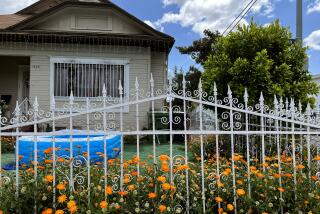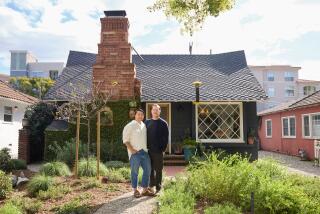GARDENING : <i> En Garde</i> : Live Fences Protect -- and Beautify
Fences define property boundaries, keep out intruders (one hopes), keep in dogs or children, rarely keep cats in or out, protect your privacy (somewhat), but seldom add visual appeal.
Living fences, on the other hand, can do all of the above and be beautiful, too. Living fences are “built” of shrubs that grow naturally dense or can be trained to do so with some assistance through pruning.
Their advantages are a lower cost of installation than wood, chain link or block wall. They provide colorful visual and physical barriers. Some accomplish this by producing attractive foliage of deep green, bronze or similar hues. Others sport colorful flowers and ornamental berries. Some also produce thorns for extra protection for both plants and property owner.
The drawback is that, as living plants, they need water, fertilizer and at least some pruning. Rarely can you get an instant fence: It takes one, two or more years for the plants to attain their full or desired height.
“There are literally hundreds of different varieties of hedges that can be used as fences,” said Macy Lindsay, a horticulturist with Hines Nursery in Irvine.
Lindsay and other experts suggest homeowners can narrow their choices by first evaluating the growing conditions of the area to be planted.
Determine how much sun the site gets. Is the soil sandy, clay or rocky? What type of garden or lawn is adjacent? Plants of similar water needs should be grouped together, and this includes the living fence. A drought-tolerant garden needs hedging of similar plant material.
Larry Steinle, a landscape architect in Laguna Beach, often uses living fences or hedges to define property lines, provide visual barriers or add vertical interest.
“Living fences are plants that can be grouped together closely and grow vertically,” he said.
The difference between living fences and hedges is that hedges can be used for mass plantings, not necessarily in a row, but appear randomly planted to create a solid block, Steinle said.
There are two categories of living fences--medium growers, from four to eight feet, and tall growers, 10 feet or more. The latter are useful when trying to block an adjacent two-story structure.
Eugenia was a very popular living fence until a voracious predator--the eugenia psyllid--attacked and disfigured the leaves. Researchers at the University of California are studying methods for eradicating these pests, which are resistant to many forms of chemical control. Parasitic wasps are being released on a limited basis, and their effects are under study.
Although control of the eugenia psyllid is hoped for within the next few years, eugenia is not yet the plant of choice.
Hines Nursery, a large wholesale grower in Irvine, is evaluating a shrub, Luma apiculata (Chilean myrtle), that may well function as a eugenia replacement.
“The form is similar to eugenia--tall, upright and fast growing. And it’s pest-resistant and needs little maintenance,” said Hines horticulturist Lindsay. “Eugenia has been tough to replace because it’s so easy to prune and shape.”
Hines is test-marketing Chilean myrtle and expects to produce large quantities within a few years. The evergreen shrub needs a sunny location and even moisture. Dense, with deep green foliage, it grows quickly to a height of 15 feet. It produces white puff-like flowers in spring and summer, followed by blue-black ornamental fruit clusters in fall.
When Lindsay added a privacy fence at her Mission Viejo home, she selected Elaeagnus pungens. The densely growing evergreen shrub is tough, drought resistant (in keeping with her garden) and will reach a maximum height of eight to 10 feet. She had only a four-foot length to install, and planted four hedges 2 1/2 feet apart. Elaeagnus produces fragrant flowers for aesthetic appeal and spiny thorns for effective barrier control.
If you want a hedge to replace fencing, be sure to select plants that are dense from the soil up, as Elaeagnus is. Not all shrubs grow in a similar fashion. Some, such as the popular privet ( Ligustrum ), may have gaps at the soil line large enough to enable a determined dog or small child to escape.
If you want a floriferous fence, consider planting roses, but not just any variety. Simplicity is a rose that was hybridized specifically as a hedge rose. Developed by Jackson & Perkins, and introduced in 1979, the original Simplicity, a pink rose, has become the most popular rose of all time, with more than 17 million sold, according to J&P.;
Several years ago, J&P; added Red Simplicity and White Simplicity to the line. In Orange County’s benevolent climate, Simplicity grows to an eventual height of five to six feet. Simplicity has good disease resistance, self-cleaning blossoms (you don’t need to remove spent blooms; the plant does it for you), and free flowering plants.
But Simplicity is not dense from the soil line, so isn’t impenetrable to children or animals. It is an excellent sight barrier. Because the plants are thorn-free, they’re excellent for bordering walkways or driveways. They need little or no pruning their first few years, and only light shaping in later years.
If you already have structural fences on your property, you can soften them by planted shrubs or vines.
Although vines have well-deserved reputations for rampant growth, they can be used very effectively to camouflage fences. Select your shrubs with care. Be sure they won’t grow too wide for their allotted space.
Plants That Double as Fences
Landscape architect Larry Steinle recommends the following for living fences:
* Bamboo: The clumping varieties are best for avoiding the invasive roots common to most bamboos. Vertical and tall-growing, they are among the most effective visual barriers.
* Arbustus Unedo ‘compacta’--Strawberry Tree: The compact variety is colorful, tight-branching and deer-resistant.
* Ceanothus ‘Julia Phelps’: This native plant (Wild Lilac) is one of the most colorful and best bloomers of all the Ceanothus varieties. C. ‘Julia Phelps’ will tolerate garden conditions and produces quantities of cobalt blue flowers.
* Escalonia ‘Fradesii’: Steinle terms this a “never-fail” plant. The six-foot evergreen shrub has glossy green leaves and showy pink flowers.
* Heteromeles arbutifolia (Toyon or California Holly): This is an easy-to-grow, dense shrub that produces small white flowers followed by berry clusters that attract birds. Its foliage is thick, leathery, glossy and dark green.
* Hibiscus Rosa Sinensis (White Wings Hibiscus): One of the showiest flowering shrubs, it can grow to 20 feet. A smaller form, White Wings Compacta, is also available.
* Leptospermum Scoparium ‘Ruby Glow’: Its reddish-tinged leaves and red flowers add beauty to most landscapes. Its needle-type leaves give the plant a lacy, heather-like appearance.
* Myrica californica (Pacific Wax Myrtle): It will grow to 20 feet but can be restrained to a lower-growing hedge. It’s easy to grow in most gardens.
* Pittosporum tobira: This is an old standby that needs room. It produces clusters of white flowers with an orange blossom fragrance. Plants can grow to 15 feet, but can be trimmed back to 6 feet.
* Podocarpus gracilior (Fern Pine): This vertical grower is good for narrow spaces. It has a fern-like leaf and is virtually pest-free.






